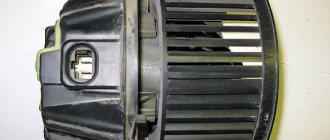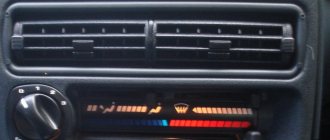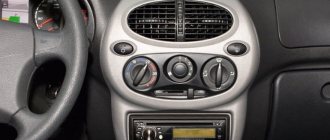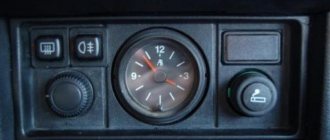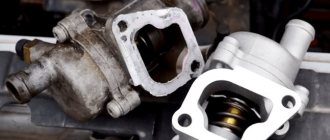Nowadays it is no longer possible to imagine a car without a heater. At least in our harsh climate. If the stove in a car fails in thirty-degree frost, then such a car will go very close. This applies to all cars, and Renault Logan is no exception. The heater radiator in this car can become a source of real headache for the car enthusiast. But fortunately, it can be replaced, and you can do it yourself. And we will dwell on this point in more detail.
Purpose of the heater radiator for Renault Logan
The heating radiator on Renault Logan performs the same function as the main radiator in the engine cooling system - it acts as a simple heat exchanger.
Heating radiators for Renault Logan are usually made of aluminum
The principle of its operation is simple. Antifreeze heated by a hot engine enters the firebox radiator, which is intensively blown by a small fan that forces hot air from the radiator grilles into special air ducts. Through them, hot air enters the car interior and heats it. The heating intensity is regulated by changing the fan rotation speed and changing the angle of rotation of a special throttle valve to admit cold air from outside.
On a Renault Logan car, the heating radiator is a regular heat exchanger
Location of the heater radiator in Renault Logan
The heating radiator is located under the instrument panel, almost at the level of the cabin floor, on the driver’s right foot. It is impossible to see it, since it is covered on all sides with plastic panels and interior upholstery. And to get to the radiator and replace it, all this coating will have to be removed. The main part of the work to replace this device involves disassembling the lining.
The device of the Renault Logan car heater
The heater is located under the dashboard in the central part. The main components of the heater are a fan, distribution dampers and a radiator.
Main components of the Renault Logan heater: 5 - distribution block; 6 — heater radiator; 7 — heater pipelines; 8 — fan resistor; 9 — front left air duct for heating the footwell; 10 — air recirculation control cable; 11 — air distribution control cable; 12 — air temperature control cable
Heater radiator
The central unit of the heating system is the heat exchanger of the heater (stove), or radiator. The main function of the radiator is to heat the air entering the cabin.
The heater radiator is responsible for heating the air entering the cabin
Heater fan
Air is actively supplied to the heater while driving through special holes in the front panel lining. When more intense air supply is needed, the fan comes into play. The faster it rotates, the more air flows to the heating systems.
The fan provides more air to the heater
Heater fan resistor
In physics, a resistor is understood as a passive element of an electrical circuit that can perform different functions: convert current into voltage and vice versa, limit current, absorb electrical energy, etc.
As part of the stove, the resistor is responsible for the operation of the fan, namely: it regulates the rotation speed of its blades. A resistor is connected to the motor and distributes the current, typically providing four fan speeds.
The resistor allows you to adjust the speed of the heater fan
Why does a resistor fail?
The cause of resistor failure is burnout. The fact is that it is constantly energized and transmits current. Experienced craftsmen, however, claim that the failure of the resistor may be associated with malfunctions or contamination of the fan as a whole.
When the resistor fails, all the electric current goes directly to the fan, and it only operates at the fourth, maximum speed. Therefore, diagnosing this breakdown will not be difficult for a car enthusiast.
How does the Renault Logan stove work?
Air enters the car interior - both naturally and with the help of a fan. Air coming from outside can pass through the radiator, thereby heating up, or past it. This depends on the position of the damper, which is connected to the temperature controller.
The radiator heats the air entering the cabin. This occurs due to the circulation, oddly enough, of coolant. It removes heat from the running engine, heats up and, in a heated state, flows through special pipes to the radiator. The maximum heating temperature can be up to 100 degrees - the system is closed and under pressure, which allows it to withstand such loads.
Heated air enters the cabin through deflectors - special openings located in the center and sides of the instrument panel. The air supply intensity is regulated using the heater control unit.
Causes of heater malfunction
If the interior of your Renault Logan becomes colder, you should not fall into depression and anxiety, since most stove breakdowns can be repaired yourself. So, let's find out which injuries are more common in older people. Renault Logan concerned the operation of the internal heater.
- The air chamber in the heat exchange system does not heat the radiator.
- The thermostat is faulty, the motor does not heat the liquid.
- The water pump is not working properly.
- Logan's hammer clattered.
- Engine malfunction.
- Little or no airflow.
- Faulty fan motor.
- The fan speed controller has failed.
- Renault mixer does not work.
The most common malfunctions in the heating system are listed above. Renault Logan. Below we will talk about each problem separately.
Problem solving
To solve the problems of the heater heater, we will try to reveal the essence of each of them.
- An air gap in the Renault heating system can be caused by premature replacement of antifreeze. Typically, the cooling system of a Renault Logan car is designed to automatically remove air pockets. The video tutorial shows how to replace the timing belt and drive belt on a Volga Cyber with your own hands. Despite the impeccable design, when cooling, as a rule, air pockets still appear. You can easily remove the air lock on your Renault Logan. Removing the front bumper on a Renault How to securely attach the bumper, part 1, item No. 196. Disconnect both pipes from the internal heat exchanger, then, connecting each pipe in turn, pour coolant into the expansion tank. After such manipulations, antifreeze should flow through the opposite pipe, after which a second pipe should be inserted. How to remove and install thresholds on Renault Duster: photo. Usually the oven heats up much better after this.
- If the thermostat does not work on the Renault Logan, the engine does not reach the desired operating temperature and the coolant cannot heat the heater radiator. It is enough to solve this problem by replacing the thermostat, the advantage is not difficult. The thermostat housing is located at the bottom of the cylinder head next to the gearbox housing.
Removing the heater system
Most Renault Logan owners are convinced that replacing the heater motor requires completely dismantling the front panel. Power steering fluid reservoir on the new Renault Logan (editorial photo of the car) How to remove the radiator of the Nissan Primera P12 heater The same position is described in the car repair and operation manual. Logan Renault Club • View topic - how to remove the heater radiator in a Logan Since such a process is quite expensive and inconvenient, many owners prefer to leave this problem unresolved. Since the operating manual (instructions) does not contain this information about the names of all liquids poured into Renault Captur, I therefore decided to collect information that is available on the Internet and in various forums. How to put on and install covers on a Renault Duster: photos and videos News How to remove the wing on a Renault Sandero However, in fact, to dismantle the housing with the heater fan it is enough to unscrew only a couple of screws. How to change the oil in the Renault Logan power steering? Everyone knows about the need to periodically replace vehicle fluids. You can handle a similar task with your own hands.
Radiator replacement
heater for
Renault Logan
, Sandero, Lada Largus Great knowledge about Renault
Why the stove
does not heat well on
Renault
Logan Sandero, Lada Largus, Nissan Almera G15, you can find out from this...
But at the very beginning, make sure that the cabin filter is clean; sometimes, due to its contamination, air cannot get into the cabin. How to change the thermostat on a Kalina Rogozin Sergey The filter is installed on the right side of the front panel.
Step-by-step instruction
Before starting work, the coolant must be drained.
1. Pull the bottom cover out of the latches and remove it. Take it as shown below and pull it to the sides (towards the doors).
2. Remove the clamp to move the carpet to the side. The clip can be pulled out with a flat screwdriver.
3. We have access to the bolts for fastening the rod that supports the rack and the torpedo is already attached to this rack. To gain access to the radiator, you need to remove the bar.
Unscrew the two bolts that are marked in the photo below.
4. Squeeze the sides and press in the clamp shown below. The harness is attached to this clamp.
5. Remove the ignition switch connector from the bracket. Squeeze the latch and tighten.
6. After removing the connector, we gain access to the track mounting nuts. Unscrew the fastening nuts and remove the bar.
Once you remove the bar, take your time, you still need to disconnect the wiring.
7. After removing the strip, we had access to the heater radiator.
8. Remove the three T20 Torx screws.
9. Place a rag under the injectors and pull them out.
10. Open the latches and remove the radiator.
The latches literally do not bend, just press them and remove the radiator.
11. Before installing a new radiator, it is recommended to blow out the seat with compressed air or clean it manually.
12. Replace the O-rings on the pipes. After replacing the rings, lightly lubricate them so that they can easily enter the radiator.
13. Install the radiator.
14. Secure the radiator with two screws.
15. Insert the pipes into the radiator and secure the mounting plate with a screw.
Make sure that when tightening the screw, the sealing rubber does not bite.
16. Next, fill in coolant, bleed the system, and remove air. Checking the tightness of the pipes.
17. If there are no leaks, install the metal rod and the rest. I don't think details are needed here.
Replacement procedure
Replacing a Renault Logan radiator will require drivers to disassemble some elements in the area of the dashboard, since the radiator itself is located behind it. In Logan this is done as conveniently as possible when compared with other cars. Drivers will only need to remove a small panel directly in the area where the pedals are located. To do this, you will need a set of keys, including Torx type, a small screwdriver, pliers and a compact flashlight. There is very little space to work, so be prepared to have to dodge around in the cabin.
The process of replacing a Renault Logan cooling radiator for a stove includes the following steps:
- Disconnect the battery.
- Next, in the engine compartment, you need to find the pipes that are directed to the heater radiator. Install clamps in front of the clamps to prevent coolant spillage. Only then can you disconnect the pipes. If you don't want to risk it, drain all the coolant completely.
- On the right side of the pedals, you need to remove the plastic casing, which is located under the instruments.
- In the area of the upholstery, use pliers to remove the clip, after which the floor carpet can be rolled away to a sufficient distance.
- The metal strip that holds the dashboard is secured with several bolts. You need to unscrew them.
- The ignition connector is also attached to the bar, which will need to be disconnected.
- Unscrew 2 screws and another bolt in the middle (here you will need a Torx wrench).
- By placing a rag under the pipes, you can disconnect them from the radiator itself.
- Be sure to check the condition of the rings and remove dirt from the ends of the pipe.
- By pressing the special latches, you can remove the radiator.
- Install a new radiator into the seat, replace the rings if necessary and lubricate them.
- Reassemble in reverse order.
As you can see, mounting the Renault Logan radiator is simplified as much as possible, since you do not have to disassemble the dashboard, remove the steering wheel and other components. As a result, the whole process will take you 20-30 minutes.
If there is still doubt about the integrity of the old radiator, you can check it for holes. To do this, one of the valves closes. The radiator is placed in a small bath of water, and a stream of air with a pressure of no more than 0.1 MPa is supplied to the inlet valve. If bubbles come from the water, then there is a hole. Assess its maintainability and only then decide whether the old radiator can still be restored or whether you should buy a new one.
To extend the life of this unit, drivers recommend periodic cleaning. The intensity depends on the air pollution in your region and the frequency of use of the stove. Naturally, do not forget to change the coolant promptly. If the coolant does not cope with its task, then even a completely new high-quality radiator will not be able to sufficiently heat the car interior.
Removing the heater radiator Renault Logan
We remove the heater radiator for replacement if a coolant leak is detected through the radiator. Drain the coolant (see “Replacing Reno Logan coolant”). We remove the instrument cluster (see “Removing the Renault Logan instrument cluster”). Remove the lower trim of the instrument panel console (see “Removing the Renault Logan instrument panel”). On the left side of the console we pull out the piston to secure the mat to the crossbar bracket...
. and bend the edge of the lid.
Using the “13” head, unscrew the two bolts of the lower fastening of the cross member bracket (the instrument panel has been removed for clarity).
Through the hole in the instrument panel (under the instrument panel), using a “13” key, unscrew the two nuts of the upper fastening of the cross member bracket.
We take out the wiring from the supports located on the inside of the bracket and remove the bracket crossbar.
Using a Torx T-20 wrench, unscrew the screw securing the pressure plate of the heater radiator hoses.
We pull out the pipes from the holes in the heater radiator tank.
Rubber O-rings are installed at the ends of the pipes.
Using a Torx T-20 wrench, unscrew the two screws for attaching the radiator.
After releasing the three latches...
... Remove the radiator from the heater housing.
Before installing the radiator, replace the rubber O-rings at the ends of the hose. Install the heater core in reverse order
Reasons for replacing heating radiators in Renault Logan
There may be two reasons why a car owner will need to change the heating radiator:
- The heater core is leaking;
- The heater core is clogged.
Leaks in heating radiators are caused by mechanical damage or corrosion. Most often, a leak occurs where the heat exchanger pipes are welded to the radiator tank. But if the radiator is subjected to very strong and prolonged shock or vibration, cracks may occur in this device.
Leaks in Renault Logan heating radiators occur as a result of mechanical damage and strong vibrations
Clogged radiator ducts are the second reason to replace the radiator. It takes a lot of time for these channels to become clogged with dirt to the point of complete blockage, and this malfunction can only be identified by elimination. If all components of the heating system are in good working order, but the stove still does not heat up, the problem is a clogged radiator, which is time to replace.
If the Renault Logan radiator is clogged, it is almost impossible to flush it
Choosing a radiator for the stove
The details are quite simple, so you don’t have to waste energy, nerves and time looking through dozens of models. The easiest way is to buy a branded factory radiator, which, in the absence of unforeseen circumstances, will work until you buy a new car. The product has catalog number 6001547484. The cost is approximately 5,000 rubles. The main advantage is the quality of the brand, the presence of new connecting rings and guaranteed compatibility with the design of the machine.
There are dozens of alternative models on the market, both cheaper and more expensive than factory products. This list includes:
- FPS 56N83;
- ASAM SA 30910;
- THERMOTEC D6R016TT;
- PROFIT 17600085;
- LUZAR LRH0998;
- MAGNETS MARELLI BRK 278.
You will have to check the processing yourself. Be sure to read the reviews of other car owners on specialized forums before purchasing. When purchasing an analogue, the main thing is to make sure that it clearly corresponds to the dimensions of the original spare part. Also pay attention to its characteristics: the number, strength of the plates and the density of their installation, the presence of additional turbulence, and the location of the valves. Round tube models are less efficient than flat tube models.
One of the main parameters when choosing such products is the material. Previously, almost all radiators were copper, but today they are being actively replaced by aluminum heat exchangers. Copper models are easy to repair, but they are among the most expensive in terms of price. Aluminum, in turn, is lighter, stronger and cheaper, but repairing holes in such a radiator is extremely problematic.
High-quality products always have a large number of plates that fit perfectly together. In budget models, honeycombs can be folded literally by hand. Of course, deformation will worsen the heat transfer of the system, so we do not recommend saving on a radiator for the stove, especially if high-quality heating of the interior is required in winter.
Location of the heater radiator in Renault Logan
The heater (heater) of Renault Logan is located in the front, in the center of the cabin, under the instrument panel. The radiator is located inside the heater at the bottom, but it can only be seen after removing the decorative plastic shell.
Autonomous heater Renault-Logan
The diagram shows the main elements of a Renault car heater, the location of which should be known to every driver:
- Distribution block.
- Radiator.
- Heater pipe.
- Interior fan resistor.
- Front left air duct for heating the footwell.
- Air recirculation control cable.
- Air distribution control cable.
- Air temperature control cable.
Selecting a motor (items)
Heater fan with air conditioner RENAULT 272-106-020R
Most cars have air conditioners , but Logan 1 has salons without such amenities.
The motors that are equipped with interior heaters without air conditioning or with it have different shapes and connectors for power connection.
Versions with air conditioning have narrow connectors, while versions without it have wider connectors. Although the location of the part is the same , the procedure for replacing it is also no different.
Heater fan without air conditioner RENAULT 6001547691
An electric motor for the interior heater is mounted in the center of the console, under the panel. Access to it is provided from below, from the right front seat. This unit (stove fan) is produced by many companies, but in almost all of them it is identical in design.
How to change the Renault Logan ignition switch yourself
Causes of failure
There are three main reasons why a radiator can fail. The first and simplest is elementary pollution. The ridges regularly become clogged with dust and small debris. This results in less heat generation. The simplest solution to the problem is to clean the radiator. You can use a regular stream of water. If you want better results, resort to chemical compounds. The main thing is that they do not destroy the metal from which the radiator itself is made. Of course, for best cleaning, it is recommended to completely disassemble the device.
The second problem is clogged channels. If you use low-quality coolant or a composition not recommended by the manufacturer, various deposits will appear on the walls. You can get rid of blockages using special cleaning products. However, the blocks can be so large that in some situations replacing the Renault Logan air conditioner radiator or stove radiator will be easier and more profitable.
The third and most dangerous malfunction is cracks, tears and other types of damage. Many auto repair shops offer repair services. Small holes can indeed be repaired, although the quality of the work is important. But to fully guarantee performance, it is recommended to purchase a new radiator and replace the damaged one.
Signs of a broken fan
The heater motor breaks down due to gradual wear of parts.
The first parts to fail are intensively rubbing parts: brushes, rings, etc., broken wires, oxidation of electrical contacts and other problems with wiring in Renault Logan 1 are less common. The stove also begins to weaken due to the developed lubricant on the rubbing surfaces.
There are certain symptoms that indicate abnormal operation of the car's heating motor. that the node will soon stop working :
- The sound of the fan changes during operation,
- the noise increases
- the heat flow weakens and becomes uneven,
- the stove cannot be turned on the first time,
- it takes too long to warm up.
A section dedicated to the repair and maintenance of Renault Logan.
Diagnosis of heater radiator malfunction
Replacing the heater radiator may be necessary in two main cases:
- radiator leak. Signs of a leak are the appearance of antifreeze on the carpet in front (under the feet of the driver and passenger), as well as a drop in the coolant level in the expansion tank;
- ineffective operation of the radiator due to clogging. In this case, with the engine warmed up to operating temperature, the stove warms up weakly, the air flow from it becomes hot only at high engine speeds.
If you identify these malfunctions, you should not be upset; you can do the work of replacing the stove radiator yourself in the garage.
When replacement is needed
This part is not included in the list of consumables, so the car manufacturer does not impose requirements regarding the frequency of replacement. From a technical point of view, the radiator is designed for the entire life of the car. The only reason it might need replacement is if the heater is faulty or has some other symptom.
Several signs indicate a breakdown of the heater core:
- Fogging of glass. If the windows in your car sweat regularly and heavily, it is possible that very hot coolant has entered the cabin, which has led to the formation of a large amount of condensation.
- The appearance of a sweet fruity smell in the cabin, most often melon. It's the smell of coolant. If it leaks, there will be a corresponding aroma in the cabin. Usually the leak can be found under the car itself, even if it is relatively small.
- Reduced coolant level. Wherever the leak occurs will affect the amount of coolant, so be sure to check your coolant levels regularly.
- Noticeable reduction in oven efficiency. If, in relatively low frosts, the furnace does not heat from the inside, it is time to diagnose, prevent or repair the system.
- Motor overheating. An indirect sign indicating low efficiency of the cooling system, which in turn is not able to completely cool the internal combustion engine due to damage to the heating radiator.
In most cases, these signs are sufficient for general diagnosis. A final conclusion can be made only after a visual inspection and a leak test. We'll talk about this further.
Sources
- https://pol-z.ru/zamena-radiatora-pechki-reno-logan/
- https://gyroscooter-izhevsk.ru/tormoza/zamena-radiatora-pechki-reno-logan.html
- https://drive2.su/lajvxaki/reno-logan-zamena-radiatora-otopitelya
- https://umelyeruki.info/avto/zamena-radiatora-otopitelya-na-reno-logan/
- https://rulikoleso.ru/remont-renault/zamena-radiatora-pechki-renault-logan
- https://k-SportRacing.ru/neispravnosti-i-remont/zamena-radiatora-pechki-na-logane.html
- https://razborov.net/renault/reno-logan-zamena-radiatora-otopitelya.html


